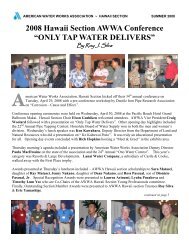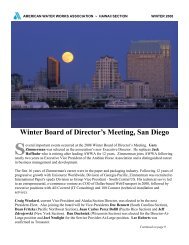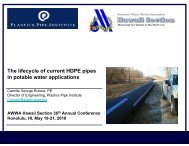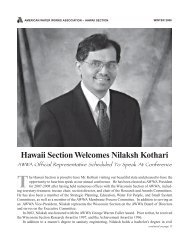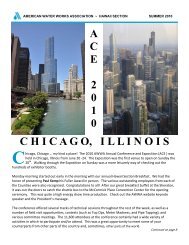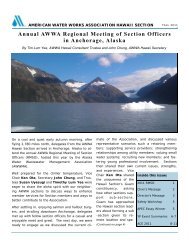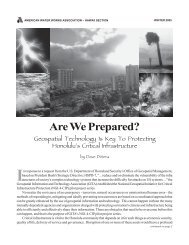Fusible Polyvinyl Chloride Pipe Provides Owner with a Monolithic ...
Fusible Polyvinyl Chloride Pipe Provides Owner with a Monolithic ...
Fusible Polyvinyl Chloride Pipe Provides Owner with a Monolithic ...
You also want an ePaper? Increase the reach of your titles
YUMPU automatically turns print PDFs into web optimized ePapers that Google loves.
Hawaii Section /American Water<br />
Works Association<br />
i<br />
Annual Conference – 19 May 2010<br />
AIRPORTS DIVISION SOUTH RAMP WATER LINE<br />
PROJECT – FUSIBLE C-900 ®<br />
Gaudencio “Dennis” Lopez<br />
Oahu District Engineer for the Hawaii Dept. of<br />
Transportation, Airport Division<br />
Rob Craw<br />
Underground Solutions, Inc.
HDOT Background <strong>with</strong> <strong>Fusible</strong> PVC<br />
TM<br />
• The District has installed two major projects <strong>with</strong> <strong>Fusible</strong> C-900<br />
®<br />
to date<br />
• Kalewa Force Main Upgrade (1200 LF) - 2008<br />
• Dillingham Airfield New Waterline Installation (800 LF) – slipline - 2009<br />
• Rehabilitated Lagoon Drive culvert crossings on an existing 14<br />
inch force main
Project Background<br />
• The South Ramp at the Honolulu International Airport (HNL)<br />
supports various commercial aviation activities including air<br />
cargo, general aviation, flight tours, etc.<br />
• The HNL water system is owned and operated by the<br />
Department of Transportation<br />
• The South Ramp pp portion of the HNL system comprises of a 16<br />
inch main on Lagoon Drive that feeds 12 inch secondary off<br />
Lagoon Drive. These arterial mains are looped together by<br />
integrating an 6 inch cast iron line originally installed by the US<br />
Navy.
SITE LOCATION
Location of Existing Waterline To Be Replaced<br />
EXISTING 6 INCH WATERLINE
Project Background<br />
S. Ramp Circa 1940’s<br />
• The 6 inch water line:<br />
• Provided water to the former<br />
Navy seaplane hangars and<br />
docks<br />
• Installed in the 1940s<br />
• 6 inch cast iron 6 inch potable<br />
water<br />
• 2300 feet<br />
• Buildings were constructed<br />
over the existing line or<br />
<strong>with</strong>in ihi near proximity i of<br />
building foundations<br />
• Concern of scale build-up up<br />
potentially reducing ID and<br />
increasing friction<br />
• Increasing frequency of<br />
breaks in the subject line<br />
Exhumed S. Ramp <strong>Pipe</strong>
Design Considerations<br />
Design:<br />
• Shimabukuro, Endo & Yoshizaki, Inc.<br />
• Pacific Geotechnical Engineers<br />
Open Trench & Horizontal Directional Drilling<br />
• Minimal Disruption<br />
• Geotechnical Consideration<br />
• Cost ($859,475.00 design estimate)<br />
Open Trench<br />
• Reasonable waterline depth<br />
• Cost ($678,795.00 design estimate)<br />
• Intrusive Construction Activity
Project Goals and Challenges<br />
Goals:<br />
• Upsize the existing line from 6 to 8 inches<br />
• Mitigate potential for hydrocarbon permeation<br />
• Reduce disruption to airfield and commercial activities<br />
Challenges:<br />
• Waterline crosses active taxilanes, roadways and parking lots<br />
• Alignment in close proximity of existing buildings and utilities<br />
• Undiscovered abandoned utilities<br />
• Relatively shallow groundwater table 5.5 to 7 feet bgs
Line Replacement Layout
Ground views<br />
SURVEYING ALIGNMENT<br />
OFFSETS NEAR TAXILANE 4<br />
TRENCH SAWCUT BY AIR<br />
SERVICE HAWAII
Basis of Design Summary:<br />
• Replace 70 year old section of 6-inch cast iron pipe and upgrade<br />
<strong>with</strong> 8 inch PVC pipe. This pipe section provides a loop<br />
network for the Honolulu International Airport South Ramp<br />
• Design Requirements and dCh Challenges<br />
• Potential for contaminated soils or groundwater due to<br />
mobile fuel farms and adjacent live fuel lines<br />
• Desire to remove gaskets/segmented pipe and limit the<br />
amount of joints in the system<br />
• <strong>Pipe</strong> system must be resistant to hydrocarbon permeation<br />
• Construction will occur over active taxilanes and roadways<br />
• Ability to deal <strong>with</strong> unforeseen abandoned utilities<br />
• Post Design Considerations<br />
• <strong>Pipe</strong> System must be resistant to Oxidative Degradation in<br />
the presence of chlorine based disinfectants (Groundwater<br />
Rule, recent studies)
• <strong>Fusible</strong> C-900<br />
®<br />
<strong>Fusible</strong> C-900<br />
®<br />
• Leak free, restrained joint pipe systems<br />
• Trenchless installation modes that reduce contractor<br />
costs<br />
• Rehabilitation capabilities for intractable high pressure<br />
water pipe pp<br />
applications<br />
• More than 1000 successful projects installed to<br />
date<br />
• In over 43 states, Canada and Mexico<br />
• Over 2000 HDD’s (directional drills) completed<br />
• Over 4000 separate pull-in instances (HDD, Slipline,<br />
<strong>Pipe</strong> Burst, Open-Cut)<br />
• Products meet all industry standards<br />
• AWWA C900, C905, NSF-61, NSF-14, PPI-TR2, ASTM<br />
Cell Classification 12454<br />
• Utilizes stock PVC fittings<br />
• Available in all water industry configurations<br />
• Quality certified by industry-leading PVC pipe extruders<br />
to AWWA standards
The Underground Solutions ® PVC Fusion Process: Utilizes<br />
Industry Standard Fusion Equipment<br />
Internal and External Bead Removal is Optional – friction losses are negligible (‘C’-factor of 150) and<br />
are significantly ifi less than mechanically joined pipe (i.e. for 8” DR18 <strong>with</strong> 1000gpm in a length of 1000LF,<br />
flow loss is 0.173 gpm and a head loss of 0.013 ft) and pipe tensile strength is not impaired<br />
(extra material in bead)
<strong>Fusible</strong> C-900<br />
® , <strong>Fusible</strong> C-905<br />
® And FPVC:<br />
Fusion Process Is Tightly Controlled<br />
• Qualified fusion technicians are trained and<br />
retrained every year by Underground<br />
Solutions<br />
• Initial 3 day course<br />
• Fusion equipment must meet minimum<br />
company standards to be approved for PVC<br />
fusion<br />
• Data loggers record critical fusion data<br />
for each joint<br />
• Provide real time feedback on joint integrity<br />
• Provide record of entire project for proof of<br />
system integrity<br />
• Fusion conditions logged by technician and<br />
“as-built” fusion joint record is developed for<br />
owner as necessary<br />
Fusion Date<br />
Nov. 29, 2007<br />
Project No. 30111<br />
Project Name<br />
Myrtle Beach 20" Force Main Diversion<br />
Jobsite Location<br />
Myrtle Beach, SC<br />
Pull No.<br />
Project Engineer<br />
Eric Kerner<br />
Fusion Technician Eric Kerner<br />
PIPE DETAILS<br />
Joint No. <strong>Pipe</strong> Dia. (in) <strong>Pipe</strong> DR Color<br />
Extruder<br />
<strong>Pipe</strong> Description<br />
20004<br />
20 DR 25 Green<br />
NAPCO<br />
FPVC<br />
EQUIPMENT IDENTIFICATION<br />
Piston<br />
Data Logger Serial IR Pyrometer<br />
Fusion Machine Identification<br />
Heat Plate Serial ID<br />
Area (in 2 )<br />
No.<br />
Serial No.<br />
T-900<br />
15.32<br />
C09247<br />
MDL3-0241 21462810604-1172<br />
A. Pressures (psi) B. Ambient Conditions / Start Time<br />
Heat<br />
131<br />
Temp. (°F)<br />
57<br />
Fusion<br />
564<br />
Weather<br />
sunny<br />
Drag<br />
50<br />
Start Time<br />
10:52 AM<br />
End Time 11:29 AM<br />
C. Heating Plate Temperature & Extrusion Marking<br />
Left Face Temperature - °F Right Face Temperature - °F<br />
412<br />
410<br />
12:00<br />
402 9:00<br />
3:00 403<br />
6:00<br />
399<br />
Piv vot<br />
12:00<br />
402 9:00<br />
3:00 395<br />
6:00<br />
399<br />
Joint Number<br />
20004<br />
15 Sept 07 @ 11:23 12 Nov 07 @ 17:47<br />
188<br />
235<br />
Record extruder pipe marking (near fusion joint) and pipe length above.
San Francisco International Airport<br />
• 750 linear feet of <strong>Fusible</strong> C-900<br />
®<br />
• 12” DR14 for new potable water<br />
line<br />
• <strong>Fusible</strong> C-900<br />
® selected for its<br />
ability to be installed in aggressive<br />
soil and groundwater conditions -<br />
petroleum hydrocarbons present<br />
• Ability to <strong>with</strong>stand oxidative<br />
degradation of chlorine based<br />
disinfectants
Design Elements<br />
ROADWAY CROSSING<br />
UTILITY CROSSING<br />
TAXILANE CROSSING<br />
VALVES & ARV’S (NOT<br />
SHOWN)<br />
SERVICE RECONNECTION<br />
(NOT SHOWN)<br />
STA 0+00<br />
STA 23+00
INCORPORATION OF FUSIBLE C-900 ® AS BASIS OF DESIGN<br />
• IMPERMEABLE TO JET FUEL AND AVGAS DUE TO PROXIMITY TO<br />
FUEL STORAGE AND HYDRANT SYSTEMS.<br />
ABOVEGROUND<br />
STORAGE TANK<br />
AND FUEL<br />
TANKER STORAGE<br />
AREA
Research indicates that HDPE can be degraded by<br />
common water disinfectants leading to Stage III<br />
“end of life failure”<br />
• Polyethylene is a polyolefin family<br />
plastic – which oxidizes <strong>with</strong>out<br />
the aid of antioxidants that are<br />
added to the HDPE formulation<br />
• Over 20 research papers published<br />
since 2004 document the failure of<br />
HDPE (PE80, PE100) pipe in the<br />
presence of water disinfectants –<br />
Stage III failure resulting from<br />
oxidation (rapid antioxidant<br />
consumption) and polymer chain<br />
scission<br />
i<br />
• North American standards (ASTM<br />
and AWWA) do not give guidance<br />
on a design factor to account for<br />
this newly documented<br />
phenomenon<br />
• Life expectancies do not consider<br />
Stage III failure<br />
• Safety factors do not consider<br />
oxidative failure mode<br />
• PVC has been demonstrated to be<br />
resistant to oxidation due to water<br />
disinfectants<br />
Hoop Stress<br />
Stage III oxidative induced cracking polyolefin family pipe – Choi 2008<br />
Chemical Aging<br />
Premature Stage<br />
III Failure<br />
Time<br />
Hydroperoxide decomposition of polyethylene under<br />
attack by chlorine dioxide – L. Audouin et al. 2007
Continuing Research Demonstrates that Aged HDPE (in<br />
Chlorinated Water) Allows Dramatically Higher Diffusion<br />
of Toluene: AWWA Research Foundation Project # 4138<br />
OIT Level<br />
Carbonyl<br />
Id Index
Incorporation of <strong>Fusible</strong> C-900 ® as Basis of<br />
Design<br />
• Reduction of gaskets through 40’ pipe length and fused joints<br />
• Ability to use DI Fittings<br />
• Use of restraint couplings <strong>with</strong> <strong>Fusible</strong> C-900<br />
® to minimize thrust<br />
blocks
Incorporation of <strong>Fusible</strong> C-900 ® as Basis of<br />
Design<br />
• UTILIZE BEND RADIUS OF PIPE THEREBY REDUCING FITTINGS<br />
VERTICAL BEND<br />
HORIZONTAL BEND
Overall Construction Sequencing<br />
• Bid Open 18 June 2009<br />
• State Project Number BO1906-73<br />
• Awarded to Ideal Construction, Inc. $624,103.00<br />
Fusion Contractor Briant Construction<br />
Material: FPVC, Underground Solutions Inc.<br />
• State Project Manager: Keith Ishinaga<br />
• Construction period December 2009 to March 2010<br />
• Challenges:<br />
Discovery of abandoned electrical jacket (transite pipe)<br />
Sensitive Construction Zone<br />
• Solutions:<br />
Take advantage of available bend radius and restraint nature of FPVC<br />
Coordination <strong>with</strong> tenants and operations
Construction Challenges<br />
• Horizontal/Vertical re-alignment<br />
• Discovery of abandoned jacket interfering <strong>with</strong> design alignment and<br />
space is available to re-align pipe.<br />
• Took advantage of the bend radius of <strong>Fusible</strong> C-900<br />
® pipe to reduce the<br />
need of fittings<br />
• Use of offset fitting (8x18) to dive under abandoned utility jacket and<br />
utilize bend radius of pipe after jacket to return to planned pipe invert<br />
thereby eby reducing the need for a second fitting<br />
Abandoned Electrical<br />
Jacket (transite pipe)<br />
<strong>Pipe</strong> Bend Around Portion of Electrical<br />
Jacket left in‐place
<strong>Fusible</strong> C-900<br />
® Layout – Joining pre-fused<br />
sections to speed construction in sensitive i<br />
areas
<strong>Fusible</strong> C-900<br />
® Layout – Fused Joint ID<br />
• All fused joints<br />
were recorded by<br />
the fusion<br />
contractor and a<br />
fusion report will<br />
be submitted to the<br />
DOTA<br />
• All fused joints<br />
were GPS surveyed<br />
by the DOTA prior<br />
to backfilling to<br />
correlate the joint<br />
report <strong>with</strong> its<br />
physical field<br />
location
<strong>Fusible</strong> C-900<br />
® Layout – Transport of Fused<br />
Sections
<strong>Fusible</strong> C-900<br />
® Layout – Installation of Toning Wire
Case Study Summary: Successful Project<br />
• A70 year old section of f6i 6-inch cast iron pipe was replaced and<br />
upgraded <strong>with</strong> 8 inch PVC pipe. This pipe section provides a<br />
loop network for the Honolulu International Airport South<br />
Ramp.<br />
• Design and Construction Challenges<br />
• <strong>Pipe</strong> system resistant to hydrocarbon permeation<br />
• <strong>Pipe</strong> System resistant to Oxidative Degradation in the presence of<br />
chlorine based disinfectants<br />
• Construction over active taxilanes and roadways<br />
• Discovery of unforeseen abandoned utilities<br />
• Solution<br />
• Design basis <strong>with</strong> <strong>Fusible</strong> C-900<br />
® created a monolothic, restrained and<br />
hydrocarbon resistant system<br />
• PVC does not exhibit Oxidative Degradation due to chlorine based<br />
disinfectants<br />
• Minimize construction time in sensitive areas by quickly joining pre-<br />
constructed fused pipe lengths<br />
• Utilize available bend radius of <strong>Fusible</strong> C-900<br />
® and restraint couplings<br />
allows for changes in the alignment reducing the number of fittings and<br />
the use of thrust blocks<br />
• New 8 inch loop line has been tested and in service.<br />
Project <strong>with</strong>in budget and on time.
Questions?



